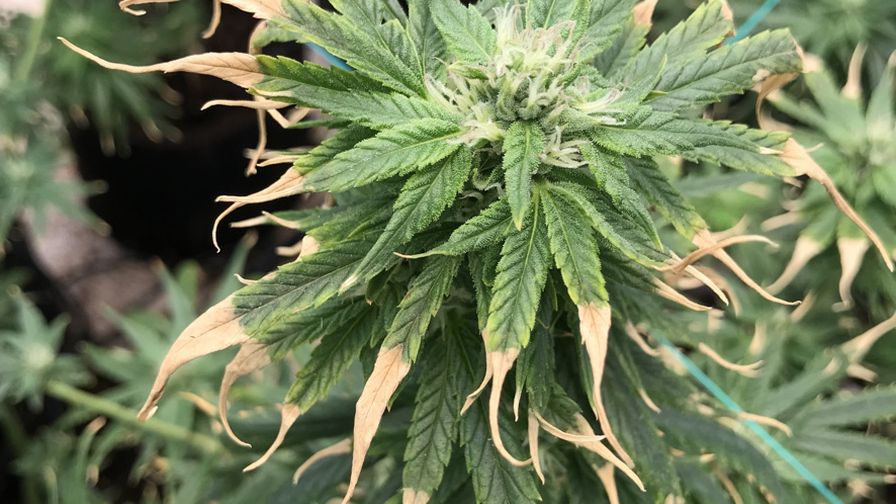A Physiological Approach to Cannabis Plant Nutrition

Cannabis buds often draw nutrients from lower leaves. Photo: Ryan Douglas/Ryan Douglas Cultivation
As a tech guy for Sunshine mixes, I’ve been dealing with cannabis growing for a long time — since when no-caller-ID phone callers used to say they were growing hybrid tomatoes. Because they were growing (so to say) in closets, the mistakes and the findings were not shared publicly.
It’s nice to be out of the closet now. I thank those good-willed growers with whom I had chats and who were open to experimenting and reporting back the results.
Though Indian Sadhis consider cannabis a mystical plant and many sinsemilla growers follow a mystical path of nutrition during its growing, there is no mystery to cannabis nutrition. However, it helps to know the physiology of cannabis, so you can synchronize cannabis nutrition with its natural traits. For example, when you supply nutrients at a low but steady level, cannabis plants can remain small, without any deficiency symptoms. But when you supply nutrients at a high level, the same plant can shoot up to 6 feet. So, by adjusting the level of nutrients, you can grow your favorite strain of cannabis in any environment. The small plant’s THC% would still be the same as the large plant, but small plants yield fewer buds. Cannabis is very flexible with regard to the level of nutrition. The plant should have proper light, temperature, and water as well.
Below are some questions to consider when addressing cannabis nutrition during the vegetative stage, including nutrient formulas, ratios, concentrations, frequency, and more.
When do you see nutrient deficiency symptoms on cannabis?
You see deficiency symptoms when a nutrient suddenly becomes unavailable to a rapidly growing cannabis plant. For example, you change to a feed program that has no nitrogen. After a couple of weeks, you see nitrogen deficiency as yellowing of old leaves. If all nutrients are there and properly balanced — even if their levels are low — you don’t see nutrient deficiency symptoms.
Where do you start with proper nutrition of cannabis?
First, test your water. Water for cannabis doesn’t have to be Aquafina. Your tap water may already have some free nutrients, like calcium or magnesium. Then, check what nutrients are in your soil mix. A soil mix with an excess baggage of nutrients — especially if their availability to cannabis is complex — would be difficult to manage. It’s better to start with a plain mix, so you can control the nutrients going into the soil mix and then into cannabis. Then add pure, simple, balanced nutrients to irrigation water.
There’s no need to juggle several nutrient jugs. Not only are such programs overly complicated and expensive, unfortunately, some of the programs cause nutrient imbalance problems. Don’t assume cannabis is like a sponge, simply taking in everything you give. Cannabis, to a large extent, selects and controls what to take in, how much, and when. For example, outside soil may have a mere 40 ppm potassium, but inside cannabis plant roots would have 5,000 ppm potassium. This just shows that cannabis actively takes in what it needs, and its uptake and nutrient levels inside are not exactly proportional to the levels a grower puts on outside. You have to distinguish between the levels of nutrients you give and the levels of nutrients that become available or unavailable in the soil and the levels of nutrients inside the plant.
What about the balance or ratios between the nutrients for cannabis?
Luckily, cannabis can survive the onslaught of the wide range of magic nutrient formulas growers give it and still manage to maintain somewhat proper nutrient ratios inside. But that doesn’t mean ratios between the nutrients you give are unimportant. When nutrient ratios are imbalanced in soil — particularly when nutrient levels are high — cannabis’ ability to acquire the nutrients it needs is compromised. Occurrence of high levels of nutrients in cannabis growing is common, as some cannabis growers follow the adage if something is good, more of it is wonderful. A good ratio for nitrogen: phosphate: potash is 1:0.5:1 and 2:1:1 for calcium: magnesium: sulfur.
How much nutrient concentrations, or ppms, should you use for cannabis?
Cannabis growth depends not just on the absolute concentration of nutrients you supply, but also on the quantity of nutrients available to it over time. As mentioned earlier, you can grow cannabis at very low nutrient concentrations, but keeping such low concentrations constantly available to your cannabis is not easy in real production. Therefore, for a safe, good production, target an EC of about 1.5 mS/cm in the root zone.
How often should you feed cannabis?
This is just like how often you should replace the milk jug in your refrigerator. Cannabis takes in the nutrients available near its roots, and those nutrients have to be replenished. Cannabis also keeps elongating roots, hoping to intercept more nutrients elsewhere in the soil. You could save cannabis energy in that search by flowing nutrients towards its roots with more frequent watering. Remember, cannabis only takes in nutrients that are dissolved.
How do you know you are feeding cannabis too much?
After cannabis takes in the nutrients it needs, you can measure the nutrients left behind by measuring the EC level of the soil. If soil EC is lower than your feed EC, then your cannabis is still hungry. If soil EC is rising above the feed EC, then you are overfeeding. Though you can measure EC easily, EC level by itself doesn’t tell which specific nutrients your cannabis is leaving behind; for that, you have to analyze the soil in a lab.
If you feed too much, wouldn’t you see toxicities on cannabis anyway?
Waiting for toxicity symptoms to appear on cannabis is too late to correct the problem. Even before showing toxicity symptoms, cannabis may just sit tight and not grow due to toxic nutrient levels. Though cannabis can ordinarily regulate entry of nutrients into it, when nutrient levels in the soil reach extreme high levels, cannabis control over nutrients coming into it breaks. Even then, cannabis attempts to compartmentalize the excess nutrients in the roots and vacuoles of leaf cells. But, if excess nutrients continue to come in, cells dehydrate and you see the result as leaf burn.
What happens inside cannabis plant tissues when you give nutrients?
When you give a nutrient, say nitrogen at 100 ppm, cannabis takes in nitrogen and its leaf nitrogen increases to say 2%. Cannabis grows at a rate proportional to that nitrogen level in the plant. Of course, cannabis has to have proper levels of all other nutrients for this growth. As more nitrogen enters cannabis, cannabis proportionately grows more, up to its genetic capacity. Like diagnosing a patient, you can analyze nutrient levels in plant tissues and use the values to know whether the nutrient levels you are giving are entering cannabis, whether cannabis is satisfied with those nutrient levels, or suffering from hidden hunger, which means you need to give more nutrients. You can also analyze specific areas of plant parts showing symptoms to find the cause of a disorder. It’s notable that cannabis is very efficient and has high rates of photosynthesis at even low nitrogen levels in leaves, but for good yields, nitrogen supply should be high.
How do you feed during the vegetative phase of cannabis?
During long light hours of vegetative phase, cannabis is receiving a lot of photon power and wants nutrients to grow fast. With good nutrition, you can see the thin, divided leaves emerging fast and the number of leaflets per leaf increasing, then growing wide — all to capture more light. You can press on the gas or brake pedal of the feed level to grow and establish a plant size you want. With this growth, the branches established now would have a bearing on the flowering and yield potential later.









